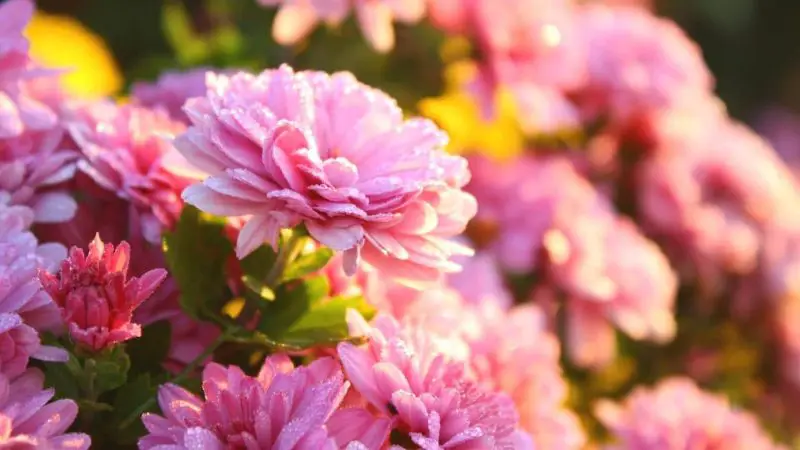Chrysanthemums, often called mums, are among the most popular flowering plants in home gardens and fall landscapes. Their dazzling range of colors, shapes, and sizes makes them a favorite for adding warmth and brightness throughout the year. Whether grown in containers, garden beds, or as decorative borders, mums thrive when provided with the right balance of sunlight. Many gardeners, however, struggle to determine exactly how much sun mums need to bloom beautifully in every season. Too little sunlight results in weak stems and sparse flowers, while too much exposure can stress the plant and reduce its blooming potential.
Understanding the light requirements of mums is the key to enjoying their full, vibrant displays. These resilient perennials love the sun, but they also appreciate protection from extreme heat and harsh rays. In this comprehensive guide, you’ll learn how to provide the perfect lighting conditions for mums year-round, discover the difference between sunlight needs for various mum types, and explore how light affects their growth and blooming cycles. With the right care and proper sun exposure, your mums will reward you with lush, colorful blooms from early summer through late autumn.
Understanding the Sunlight Needs of Mums

To grow mums that bloom beautifully in all seasons, it’s essential to understand their relationship with sunlight. Chrysanthemums are considered sun-loving plants, which means they need plenty of light to develop strong stems and abundant blooms. In general, mums thrive best when they receive at least six hours of direct sunlight each day. Sunlight fuels the process of photosynthesis, allowing the plant to produce the energy needed for growth and flower formation. When mums receive sufficient light, their blooms appear larger, more colorful, and longer-lasting. On the other hand, mums grown in shady conditions tend to produce fewer flowers and develop weak, leggy stems that can’t support the weight of the blooms.
However, while mums enjoy full sun, the intensity and duration of sunlight should be balanced according to climate and season. In cooler regions, full sun exposure throughout the day promotes compact growth and vibrant colors. But in hotter climates, intense afternoon sunlight can cause the leaves to scorch or the soil to dry too quickly. In such areas, providing partial shade during the hottest part of the day helps protect the plants without hindering their growth. This balance ensures the plant receives enough energy for blooming while avoiding stress caused by overheating or dehydration.
The direction of sunlight also influences how mums grow. Mums planted in areas with southern or southeastern exposure often receive ideal light conditions, as they get bright morning sun and softer afternoon rays. Indoor mums, or those grown in containers, should be placed near windows where they can soak up natural light but remain shielded from harsh, direct heat. Once you understand how to balance light intensity, direction, and duration, you’ll be able to cultivate mums that flourish with strong stems, lush foliage, and breathtaking blooms season after season.
Different Types of Mums and Their Sunlight Preferences
Garden Mums (Chrysanthemum morifolium)
Garden mums, also known as hardy mums, are the most common type found in home landscapes. These resilient plants are bred to withstand fluctuating weather and can bloom beautifully with full sun exposure. Ideally, garden mums should receive six to eight hours of direct sunlight daily. Morning sun is especially beneficial because it helps dry dew from the leaves, reducing the risk of fungal diseases. Too much shade can cause the stems to grow long and weak, while the blooms become small and sparse. In cooler climates, full-day sunlight enhances flower color and prolongs the blooming period.
In warmer regions, however, intense midday sunlight can sometimes overwhelm the plant. Providing a few hours of afternoon shade helps prevent heat stress, especially during the peak of summer. Garden mums perform exceptionally well in open, airy spaces where sunlight is consistent and the soil drains quickly. With proper exposure, they produce dense foliage and clusters of vibrant flowers in shades of yellow, orange, pink, red, and white, transforming any garden into a seasonal masterpiece.
Florist Mums (Chrysanthemum × grandiflorum)
Florist mums, also known as cutting mums, are typically grown for indoor displays and floral arrangements rather than outdoor planting. They thrive in bright but indirect sunlight, making them perfect for windowsills or sunlit rooms. These mums require about four to six hours of filtered light per day to maintain healthy foliage and consistent flowering. Direct afternoon sunlight should be avoided, as it can cause leaf burn or dry out the soil too quickly. When grown indoors, rotating the plant every few days ensures all sides receive even light exposure, keeping the shape symmetrical and the growth balanced.
For outdoor care, florist mums can be acclimated to morning sun but should always be protected during midday. They are more sensitive than hardy garden mums and benefit from being placed in semi-shaded spots with consistent humidity. Using sheer curtains or shade cloths to diffuse sunlight works well for potted florist mums. When provided with the right balance of brightness and protection, they produce large, richly colored blooms that last for weeks, making them a favorite for decorative arrangements and gifts.
Cushion Mums (Dendranthema hybrids)
Cushion mums are compact, dome-shaped varieties that create a carpet of color when in full bloom. These hardy perennials thrive in bright, direct sunlight but also tolerate light partial shade. Ideally, they should receive at least six hours of sun daily for maximum flowering. The more sunlight cushion mums receive, the denser their foliage and the more abundant their blooms become. Too little sun causes them to spread unevenly and produce fewer flowers. Full sun exposure encourages their signature cushion-like form and helps maintain compact growth.
In extremely hot climates, it’s best to give cushion mums morning sunlight and filtered shade during the afternoon. Their shorter stature makes them more susceptible to heat from reflected surfaces like patios or driveways, so keeping them slightly sheltered is beneficial. Consistent watering and well-drained soil complement their sun needs perfectly. With proper sunlight management, cushion mums deliver a stunning display of blooms that cover the entire plant, making them ideal for borders, walkways, and garden edges.
How Sunlight Affects Mums’ Blooming Cycles
Sunlight has a powerful influence on how and when mums bloom. As photoperiodic plants, chrysanthemums respond to changes in daylight length — they start forming flower buds when nights grow longer in late summer and early autumn. However, their ability to bloom fully depends on how much sunlight they receive during the growing months. When mums are exposed to at least six hours of bright sunlight per day, their stems grow stronger, their leaves become greener, and they produce more flower buds. Without enough sunlight, the plant diverts its energy toward leaf production instead of blooming, resulting in sparse flowers and uneven growth. Proper sunlight during spring and summer builds the foundation for a spectacular fall display.
The timing and intensity of sunlight also determine bloom quality and longevity. If mums are subjected to harsh, prolonged sunlight in midsummer, the extreme heat can stress the plant and cause premature flowering with smaller, less vibrant blooms. Conversely, too little light delays budding and weakens stem development. Gardeners in warmer climates can prevent this by providing partial afternoon shade, while those in cooler regions should give their mums full sun exposure. Consistent, moderate sunlight keeps the plant’s growth cycle synchronized, ensuring buds develop evenly across the entire plant.
Light exposure also affects flower color and size. Mums grown in full, balanced sunlight often display richer pigments and more uniform blooms compared to those grown in shade. Bright light enhances the intensity of yellows, reds, and purples, while shaded plants tend to produce lighter, duller hues. Regularly monitoring sunlight and adjusting the plant’s position ensures healthy, synchronized flowering that lasts longer through the season. By understanding how sunlight shapes blooming behavior, you can create the perfect environment for your mums to flourish beautifully year after year.
How to Adjust Sunlight Exposure for Mums in Different Seasons
Adjusting sunlight exposure for mums throughout the year is the secret to maintaining strong growth and continuous blooming. In spring, mums begin their active growing phase and need as much sunlight as possible to develop a sturdy foundation. During this time, place them in full sun for six to eight hours daily. The mild temperatures and gentle light of spring promote healthy roots and dense foliage. Outdoor mums should be positioned in open garden beds where they can absorb maximum light. For indoor varieties, bright windows that receive morning sun work perfectly. This stage is crucial because it helps the plant store energy for its vibrant fall blooms.
In summer, sunlight becomes stronger and more intense, which can sometimes overwhelm mums, especially in warmer climates. To prevent leaf scorch and wilting, provide partial shade during the hottest part of the afternoon. Early morning light remains beneficial, but direct midday exposure can be harmful. You can use a shade cloth or position potted mums where taller plants or fences offer filtered sunlight. Keeping the soil consistently moist helps regulate temperature and prevents stress. If grown indoors, place mums a few feet from sunny windows and diffuse the light with sheer curtains. This ensures they continue growing steadily without burning or drying out.
As autumn and winter arrive, natural light weakens, and mums require as much brightness as possible to maintain their blooms. Outdoor mums should be moved to spots with southern exposure for maximum light. Indoors, supplement sunlight with LED grow lights if needed. During winter dormancy, gradually reduce light to mimic nature’s seasonal rhythm. Adapting sunlight to seasonal changes keeps mums balanced, allowing them to thrive through cycles of rest and renewal while ensuring vibrant, full blooms each year.
Signs Your Mums Are Getting Too Much or Too Little Sun
Recognizing how mums respond to sunlight is key to maintaining their beauty and health. When mums receive too much sun, especially during the peak of summer, their leaves may start to show visible signs of stress. The foliage often turns yellow or brown at the edges, and you might notice dry, brittle patches or scorched spots. In severe cases, the entire plant may wilt even though the soil is moist. Blooms may fade prematurely, losing their rich color and shape. These symptoms indicate sunburn caused by excessive exposure to harsh afternoon light. The best solution is to move your mums to a location with filtered or partial shade, where they can still enjoy bright light without direct heat.
On the other hand, mums that receive too little sunlight will struggle to grow compactly and bloom properly. Their stems become elongated and weak, reaching toward the nearest light source. The foliage may appear pale green, and the number of flower buds will be noticeably reduced. When they do bloom, the flowers are smaller and less vibrant than usual. Shaded conditions also increase the risk of fungal issues because the soil remains damp longer. To fix this, move the plant to a sunnier location where it can get at least six hours of morning or early afternoon sunlight daily. Balanced exposure quickly restores color and vigor.
Consistent observation helps you adjust lighting before problems become severe. Mums thrive in steady light rather than abrupt shifts between sun and shade. Gradual changes in placement or the use of sheer coverings can protect them during extreme conditions. By understanding the warning signs and responding early, you ensure your mums receive just the right amount of sunlight. The result is lush foliage, strong stems, and long-lasting blooms that radiate health and color throughout every season.
Indoor vs Outdoor Mums: Managing Sunlight Exposure
Indoor Mums and Light Conditions
These colorful blooms brighten any home but need well-managed light to stay healthy and continue blooming. These mums prefer bright, indirect sunlight rather than harsh, direct rays. A spot near an east- or south-facing window is ideal, as it provides soft morning light that encourages flowering without overheating the plant. If natural light is limited, especially in winter, you can supplement it with fluorescent or LED grow lights placed about 12 inches above the plant. Keep the lights on for 12 to 14 hours per day to mimic natural daylight cycles. Proper lighting ensures compact, healthy growth and prevents the stems from stretching toward the light source.
Rotating your mums every few days also helps maintain an even shape, as it prevents one side from leaning toward the window. Avoid placing them near drafty windows, heaters, or vents since fluctuating temperatures can stress the plant. If leaves begin to yellow or buds fail to open, it’s often a sign the plant isn’t receiving enough light. Adjusting its position to a brighter area can quickly restore its health and encourage more buds to form. With consistent light and moderate indoor temperatures, mums can bloom beautifully for weeks, filling your space with color and freshness.
Outdoor Mums and Sun Management
Outdoor mums thrive when planted in full sun but need thoughtful positioning to handle seasonal changes. They perform best with six to eight hours of direct sunlight each day, preferably during the morning and early afternoon. Morning sun helps dry dew and prevents fungal diseases, while excessive afternoon heat can cause stress. In hot climates, providing partial shade after midday helps preserve leaf color and prolong the blooming period. Placing mums near taller plants, trees, or fences can naturally filter the harshest rays.
Container-grown outdoor mums offer flexibility, allowing you to move them based on light intensity. During cooler months, full sun exposure promotes compact growth and abundant blooms, but as summer intensifies, shifting them to shaded areas ensures they remain healthy. Regular watering and mulch also help protect roots from overheating. Observing how your mums respond to seasonal sunlight lets you fine-tune their placement for consistent results. With proper sun management, outdoor mums reward gardeners with strong, resilient plants that bloom profusely and maintain vibrant colors year after year.
Best Locations for Growing Mums Based on Light Conditions
Choosing the right location for your mums is one of the most important factors for achieving lush growth and vibrant blooms. Mums love sunlight, but their performance depends greatly on where they’re planted. In outdoor gardens, the best location is one that receives full morning sun and light afternoon shade. East- or southeast-facing areas are ideal because they allow mums to soak up gentle sunlight that promotes strong stems and rich flower color while protecting them from harsh midday rays. Avoid planting them under dense trees or in areas that stay shaded for most of the day, as this will reduce their ability to produce buds. Good air circulation is also essential, so avoid crowded spots where humidity builds up easily. This balance of sun and airflow prevents disease and helps the plant flourish naturally.
For container mums, flexibility is the key advantage. They can be moved based on the season or light intensity. In spring and fall, when the sunlight is mild, place potted mums in open, sunny spaces such as patios, balconies, or garden edges where they can receive direct light for six to eight hours daily. During hot summer months, shift the pots slightly to shaded corners or under pergolas where the light is bright but filtered. This adaptability allows you to control the light exposure precisely and prevent leaf scorch or bloom fading caused by excessive heat.
Indoor mums require placement near bright windows that offer indirect light throughout the day. South- and east-facing windows are the best choices, as they provide warmth and steady brightness. If your home doesn’t get enough sunlight, consider adding artificial grow lights to maintain healthy foliage and encourage continuous blooms. The goal is to mimic natural light conditions as closely as possible. Whether you’re growing mums indoors or outdoors, providing the right balance of sunlight ensures they remain healthy, compact, and full of colorful, long-lasting flowers across every season.
Combine Light, Temperature and Water for Perfect Growth
Achieving perfect mum growth depends on maintaining the right balance between light, temperature, and water. These three factors work together to determine the strength of stems, the size of blooms, and the overall health of the plant. Mums thrive in bright light, needing at least six hours of direct sunlight daily to produce dense foliage and vibrant flowers. However, light alone isn’t enough — it must be paired with stable temperatures and proper hydration. The ideal temperature range for mums is between 60°F and 70°F (15°C–21°C) during the day and slightly cooler at night. This balance encourages steady growth while preventing heat stress. In regions with hotter climates, providing partial afternoon shade and consistent moisture helps mums maintain energy for bud formation and flowering.
Water plays a crucial role in supporting both temperature regulation and light absorption. Mums prefer consistently moist but well-drained soil. Allowing the soil to dry out completely can cause wilting and reduced bloom production, while overwatering may lead to root rot. To maintain proper moisture, water deeply at the base of the plant rather than overhead. This prevents fungal diseases and ensures the roots absorb water efficiently. During hot or windy days, check the soil more frequently, as evaporation occurs faster. In cooler weather, reduce watering but never let the soil become bone dry. Consistent, moderate watering keeps mums hydrated and helps them respond better to sunlight exposure.
The interplay of light, temperature, and water determines the overall vitality of mums. Too much sunlight combined with dry soil causes leaf scorch, while excess water under low light conditions can trigger rot. The goal is balance — warm temperatures, steady moisture, and sufficient sunlight. When these elements align, mums grow compact, develop rich colors, and bloom longer. Adjusting these factors with the changing seasons ensures that your mums not only survive but thrive, showcasing their full beauty from early summer to late fall.
Common Mistakes Gardeners Make with Mum Sunlight
Giving Mums Too Much Direct Sun
One of the most frequent mistakes gardeners make is exposing mums to too much direct sunlight, especially during hot summer months. While mums love the sun, excessive exposure to intense midday rays can cause more harm than good. Their leaves may begin to yellow or brown, and flower petals can fade or shrivel prematurely. In extreme heat, the soil dries out faster, leading to dehydration and wilting, even with regular watering. This stress weakens the plant and reduces blooming potential. To prevent this, mums should receive full morning sun but be shielded from the harsh afternoon light. Providing partial shade through nearby trees, pergolas, or shade cloths helps maintain the right balance.
Monitoring soil moisture is also crucial when sunlight is strong. If the top inch of soil feels dry, it’s time to water deeply. Mulching around the base of the plant can further protect roots from overheating. By moderating sunlight exposure during peak heat, mums will remain vibrant and continue producing healthy, long-lasting blooms. Balanced sunlight encourages compact growth and helps the plant conserve energy for steady flowering throughout the season.
Growing Mums in Too Much Shade
At the other end of the spectrum, placing mums in too much shade can drastically reduce their blooming performance. Mums grown without adequate light often develop long, spindly stems as they stretch toward any available light source. Their foliage turns pale green, and the number of flower buds decreases significantly. In heavy shade, the plant may not bloom at all, focusing instead on weak, leafy growth. Without sufficient sunlight, mums can also become prone to fungal diseases, as shaded, damp environments encourage mold and mildew.
To correct this, move shaded mums to a location where they can receive at least six hours of sunlight daily, preferably in the morning or early afternoon. If growing indoors, place the pots near a bright window or supplement with grow lights. Gradually increasing light exposure helps prevent shock and stimulates bud formation. With the right amount of sunlight, mums will quickly regain strength, producing lush foliage and abundant blooms. Balanced light is the foundation for healthy, vibrant chrysanthemums that flourish through the growing season.
FAQs About Mum Sunlight Requirements
How many hours of sunlight do mums need each day?
Mums need at least six hours of direct sunlight daily to grow strong and bloom abundantly. Morning sunlight is best because it provides energy without overheating the plant. In cooler climates, mums can handle full-day sun, while in hotter areas, partial shade during the afternoon helps prevent leaf scorch and stress.
Can mums grow in full shade?
No, mums do not thrive in full shade. Without enough light, their stems become leggy, blooms are sparse, and colors fade quickly. Shade-grown mums also have weaker root systems and are more prone to fungal diseases. For best results, provide bright, indirect sunlight or filtered morning sun for several hours each day.
Is afternoon sunlight too strong for mums?
Yes, in most regions, direct afternoon sunlight can be too intense for mums, especially during summer. Prolonged exposure to high heat and bright rays can cause leaves to burn or dry out. The ideal approach is to give mums morning sunlight and provide light shade after midday to maintain their health and vibrant color.
Can I grow mums indoors with artificial light?
Yes, mums can grow indoors with artificial light if natural sunlight is limited. LED or fluorescent grow lights work best, offering 12 to 14 hours of brightness daily. Position the lights about 12 inches above the plants and maintain consistent moisture to mimic outdoor conditions. Regular rotation ensures even growth and balanced blooms.
Why are my mums not blooming even though they get sun?
If your mums aren’t blooming, it might be due to irregular light exposure or too much heat. Mums also need a balance between daylight and darkness to trigger bud formation. Try moving them to a spot with morning sun and cooler temperatures. Avoid excessive fertilizer, which can promote leafy growth instead of blooms.






